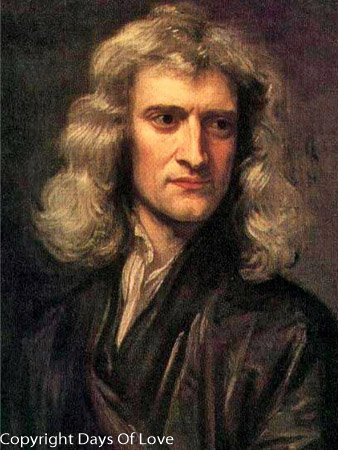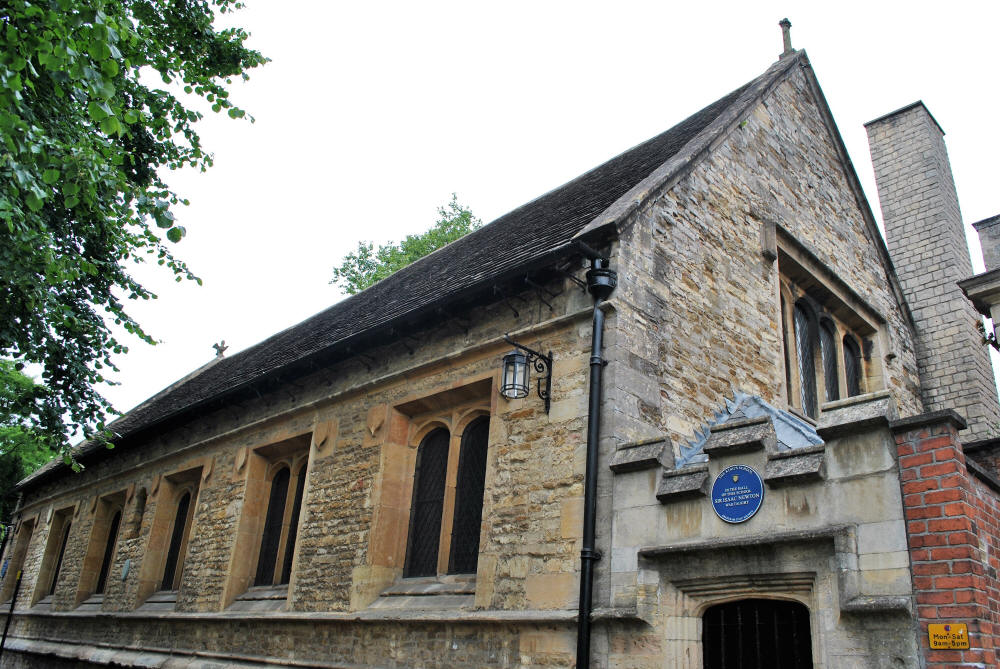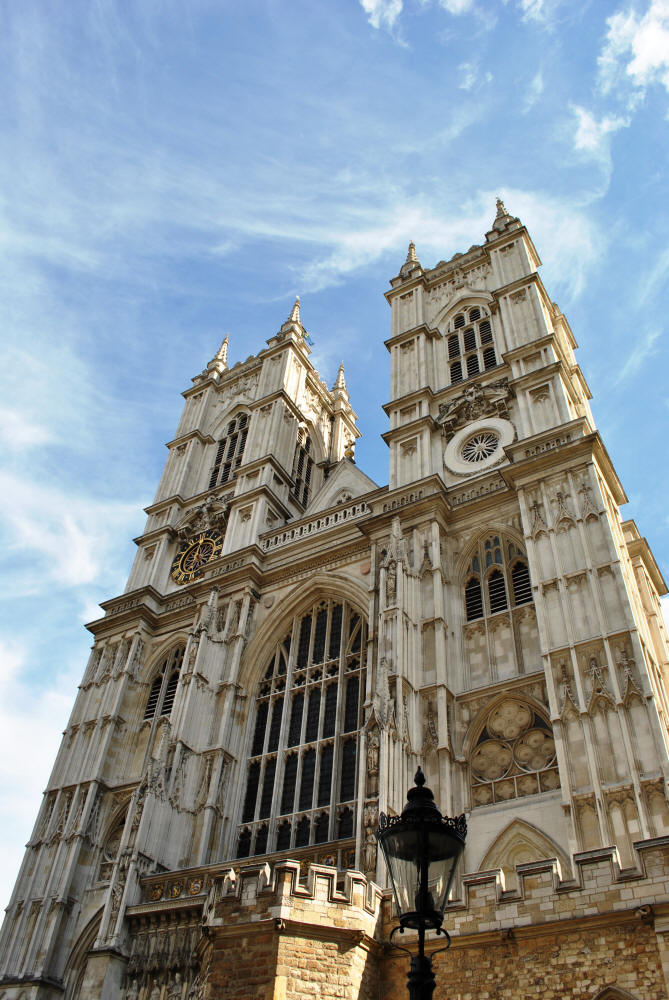
Queer Places:
University of Cambridge, 4 Mill Ln, Cambridge CB2 1RZ
The King's School, Brook St, Grantham NG31 6RP, Regno Unito
87 Jermyn St, St. James's, London SW1Y 6JD, Regno Unito
Bullingham Mansions, Kensington Church St, Kensington, London W8 4BE, Regno Unito
Westminster Abbey, 20 Deans Yd, Westminster, London SW1P 3PA, Regno Unito
 Sir
Isaac Newton PRS (25 December 1642 – 20 March 1726/27[1])
was an English mathematician, astronomer, theologian, author and physicist
(described in his own day as a "natural philosopher") who is widely recognised
as one of the most influential scientists of all time and a key figure in the
scientific revolution. His book Philosophiæ Naturalis Principia Mathematica
("Mathematical Principles of Natural Philosophy"), first published in 1687,
laid the foundations of classical mechanics. Newton also made pathbreaking
contributions to optics, and he shares credit with Gottfried Wilhelm Leibniz
for developing the infinitesimal calculus.
Sir
Isaac Newton PRS (25 December 1642 – 20 March 1726/27[1])
was an English mathematician, astronomer, theologian, author and physicist
(described in his own day as a "natural philosopher") who is widely recognised
as one of the most influential scientists of all time and a key figure in the
scientific revolution. His book Philosophiæ Naturalis Principia Mathematica
("Mathematical Principles of Natural Philosophy"), first published in 1687,
laid the foundations of classical mechanics. Newton also made pathbreaking
contributions to optics, and he shares credit with Gottfried Wilhelm Leibniz
for developing the infinitesimal calculus.
Newton's Principia formulated the laws of motion and universal
gravitation that dominated scientists' view of the physical universe for the
next three centuries. By deriving Kepler's laws of planetary motion from his
mathematical description of gravity, and using the same principles to account
for the trajectories of comets, the tides, the precession of the equinoxes,
and other phenomena, Newton removed the last doubts about the validity of the
heliocentric model of the Solar System and demonstrated that the motion of
objects on Earth and of celestial bodies could be accounted for by the same
principles. Newton's theoretical prediction that the Earth is shaped as an
oblate spheroid was later vindicated by the geodetic measurements of
Maupertuis, La Condamine, and others, thus convincing most Continental
European scientists of the superiority of Newtonian mechanics over the earlier
system of Descartes.
Newton also built the first practical reflecting
telescope and developed a sophisticated theory of colour based on the
observation that a prism decomposes white light into the colours of the
visible spectrum. Newton's work on light was collected in his highly
influential book Opticks, first published in 1704. He also formulated
an empirical law of cooling, made the first theoretical calculation of the
speed of sound, and introduced the notion of a Newtonian fluid. In addition to
his work on calculus, as a mathematician Newton contributed to the study of
power series, generalised the binomial theorem to non-integer exponents,
developed a method for approximating the roots of a function, and classified
most of the cubic plane curves.

The King's School, Grantham

Westminster Abbey, London
.JPG)
Trinity College, Cambridge
Newton was a fellow of Trinity College and the second Lucasian Professor of
Mathematics at the University of Cambridge. He was a devout but unorthodox
Christian, who privately rejected the doctrine of the Trinity and who,
unusually for a member of the Cambridge faculty of the day, refused to take
holy orders in the Church of England. Beyond his work on the mathematical
sciences, Newton dedicated much of his time to the study of alchemy and
biblical chronology, but most of his work in those areas remained unpublished
until long after his death. Politically and personally tied to the Whig party,
Newton served two brief terms as Member of Parliament for the University of
Cambridge, in 1689–90 and 1701–02. He was knighted by Queen Anne in 1705 and
he spent the last three decades of his life in London, serving as Warden
(1696–1700) and Master (1700–1727) of the Royal Mint, as well as president of
the Royal Society (1703–1727).
Although it was claimed that he was once engaged,[97]
Newton never married. The French writer and philosopher Voltaire, who was in
London at the time of Newton's funeral, said that he "was never sensible to
any passion, was not subject to the common frailties of mankind, nor had any
commerce with women—a circumstance which was assured me by the physician and
surgeon who attended him in his last moments".[98]
The widespread belief that he died a virgin has been commented on by writers
such as mathematician Charles Hutton,[99]
economist
John Maynard Keynes,[100]
and physicist Carl Sagan.[101]
Newton did have a close friendship with the
Swiss mathematician
Nicolas Fatio de Duillier, whom he met in London around 1689.[63]
Their intense relationship came to an abrupt and unexplained end in 1693, and
at the same time Newton suffered a nervous breakdown.[102]
Some of their correspondence has survived.[103][104]
In September of that year, Newton had a breakdown which included sending
wild accusatory letters to his friends Samuel Pepys and John Locke. His note
to the latter included the charge that Locke "endeavoured to embroil me with
woemen".
Newton died in his sleep in London on 20 March 1727 (OS 20 March 1726; NS
31 March 1727).[1]
His body was buried in Westminster Abbey.[93]
Voltaire may have been present at his funeral.[94]
A bachelor, he had divested much of his estate to relatives during his last
years, and died intestate.[95]
His papers went to John Conduitt and Catherine Barton.[96]
After his death, Newton's hair was examined and found to contain mercury,
probably resulting from his alchemical pursuits. Mercury poisoning could
explain Newton's eccentricity in late life.[95]
My published books:


BACK TO HOME PAGE

- During Newton's
lifetime, two calendars were in use in Europe: the
Julian ("Old
Style") calendar in
protestant and
Orthodox regions, including Britain; and the
Gregorian ("New
Style") calendar in Roman Catholic Europe. At Newton's birth,
Gregorian dates were ten days ahead of Julian dates: thus his birth is
recorded as taking place on 25 December 1642 Old Style, but can be
converted to a New Style (modern) date of 4 January 1643. By the time of
his death, the difference between the calendars had increased to eleven
days: moreover, he died in the period after the start of the New Style
year on 1 January, but before that of the Old Style new year on 25 March.
His death occurred on 20 March 1726 according to the Old Style calendar,
but the year is usually adjusted to 1727. A full conversion to New Style
gives the date 31 March 1727. See Thony, Christie (2015) Calendrical
confusion or just when did Newton die?, The Renaissance Mathematicus,
retrieved 20 March 2015 from
https://thonyc.wordpress.com/2015/03/20/calendrical-confusion-or-just-when-did-newton-die/
-
"Fellows of the Royal Society". London: Royal Society. Archived from
the original on 16 March 2015.
- Feingold, Mordechai.
Barrow, Isaac (1630–1677), Oxford Dictionary of National Biography,
Oxford University Press, September 2004; online edn, May 2007;
retrieved 24 February 2009; explained further in Mordechai Feingold's "Newton,
Leibniz, and Barrow Too: An Attempt at a Reinterpretation" in Isis,
Vol. 84, No. 2 (June 1993), pp. 310–38.
-
Newton profile, Dictionary of Scientific Biography, n.4.
-
Gjertsen 1986, p. [page needed]
-
"Newton" entry in
Collins English Dictionary.
-
"Isaac Newton, horoscope for birth date 25 December 1642 Jul.Cal".
Astro-Databank Wiki. Retrieved
4 January 2017.
-
Storr, Anthony (December 1985). "Isaac
Newton". British Medical Journal (Clinical Research Edition). BMJ.
291 (6511): 1779.
doi:10.1136/bmj.291.6511.1779.
JSTOR 29521701.
-
Keynes, Milo (20 September 2008).
"Balancing Newton's Mind: His Singular Behaviour and His Madness of
1692–93". Notes and Records of the Royal Society of London. 62
(3): 293.
doi:10.1098/rsnr.2007.0025.
JSTOR 20462679.
- "Newton the
Mathematician" Z. Bechler, ed., Contemporary Newtonian Research(Dordrecht
1982) pp 110 – 111
-
Hoskins, Michael, ed. (1997). Cambridge
Illustrated History of Astronomy.
Cambridge University Press. p. 159.
ISBN 978-0521411585.
-
Newton, Isaac.
"Waste Book". Cambridge University Digital Library.
Retrieved 10 January 2012.
-
"Newton, Isaac (RY644J)". A Cambridge Alumni Database.
University of Cambridge.
- D T Whiteside (ed.),
The Mathematical Papers of Isaac Newton (Volume 1), (Cambridge
University Press, 1967), part 7 "The October 1666 Tract on Fluxions",
at page 400, in 2008 reprint.
- Newton, 'Principia',
1729 English translation,
at page 41.
- Newton, 'Principia',
1729 English translation,
at page 54.
- Clifford Truesdell,
Essays in the History of Mechanics (Berlin, 1968), at p.99.
- In the preface to the
Marquis de L'Hospital's Analyse des Infiniment Petits (Paris,
1696).
- Starting with
De motu corporum in gyrum, see also
(Latin) Theorem 1.
- D T Whiteside (1970),
"The Mathematical principles underlying Newton's Principia Mathematica" in
Journal for the History of Astronomy, vol.1, pages 116–138,
especially at pages 119–120.
-
Błaszczyk,
Piotr;
Katz, Mikhail; Sherry, David (2012), "Ten misconceptions from the
history of analysis and their debunking",
Foundations of Science, 18: 43,
arXiv:1202.4153 ,
doi:10.1007/s10699-012-9285-8
-
King, Henry C (2003).
The History of the Telescope. p. 74.
ISBN 978-0-486-43265-6.
-
Whittaker, E. T., A History of the Theories of Aether and
Electricity, Dublin University Press, 1910.
-
Olivier Darrigol (26 January 2012).
A History of Optics from Greek Antiquity to the Nineteenth Century.
Oxford University Press. p. 81.
ISBN 978-0-19-964437-7.
-
Newton, Isaac.
"Hydrostatics, Optics, Sound and Heat". Cambridge University Digital
Library. Retrieved
10 January 2012.
-
William R. Newman, "Newton's Early Optical Theory and its Debt to
Chymistry," in Danielle Jacquart and Michel Hochmann, eds., Lumière et
vision dans les sciences et dans les arts (Geneva: Droz, 2010), pp.
283–307. A free access online version of this article can be found at
the Chymistry of Isaac Newton project
-
"The Early Period (1608–1672)". James R. Graham's Home Page.
Retrieved 3 February 2009.[permanent
dead link]
-
White 1997, p. 170
-
Hall, Alfred Rupert (1996).
Isaac Newton: adventurer in thought. p. 67.
ISBN 978-0-521-56669-8.
-
Newton, Isaac.
"Of Colours". The Newton Project.
Retrieved 6 October 2014.
- See
'Correspondence of Isaac Newton, vol. 2, 1676–1687' ed. H W Turnbull,
Cambridge University Press 1960; at page 297, document No. 235, letter
from Hooke to Newton dated 24 November 1679.
- Iliffe, Robert (2007)
Newton. A very short introduction, Oxford University Press 2007
-
Westfall, Richard S. (1983) [1980]. Never
at Rest: A Biography of Isaac Newton. Cambridge: Cambridge University
Press. pp. 530–1.
ISBN 978-0-521-27435-7.
-
Keynes, John
Maynard (1972). "Newton, The Man". The Collected Writings of John
Maynard Keynes Volume X. MacMillan St. Martin's Press. pp. 363–4.
-
Dobbs, J.T.
(December 1982). "Newton's Alchemy and His Theory of Matter". Isis.
73 (4): 523.
doi:10.1086/353114.
quoting Opticks
- Opticks, 2nd Ed 1706.
Query 8.
-
Duarte, F. J. (2000).
"Newton, prisms, and the 'opticks' of tunable lasers"
(PDF). Optics and Photonics News.
11 (5): 24–25.
Bibcode:2000OptPN..11...24D.
doi:10.1364/OPN.11.5.000024.
- Tyndall, John. (1880).
Popular Science Monthly Volume 17, July.
s:Popular Science Monthly/Volume 17/July 1880/Goethe's Farbenlehre: Theory
of Colors II
- D T Whiteside (ed.),
'Mathematical Papers of Isaac Newton', vol.6, 1684–1691, Cambridge
University Press 1974, at page 30.
- See Curtis Wilson,
"The Newtonian achievement in astronomy", pages 233–274 in R Taton & C
Wilson (eds) (1989) The General History of Astronomy, Volume, 2A',
at page 233.
- Text quotations are
from 1729 translation of Newton's Principia, Book 3 (1729 vol.2)
at pages 232–233.
- Edelglass et al.,
Matter and Mind,
ISBN 0-940262-45-2.
p. 54
- On the meaning and
origins of this expression, see Kirsten Walsh,
Does Newton feign an hypothesis?,
Early Modern Experimental Philosophy, 18 October 2010.
-
Professor Robert A. Hatch, University of
Florida.
"Newton Timeline". Retrieved
13 August 2012.
- Conics and Cubics,
Robert Bix, Springer
Undergraduate Texts in Mathematics, 2nd edition, 2006, Springer
Verlag.
-
"John Locke Manuscripts – Chronological Listing: 1690". psu.edu.
- John C. Attig,
John Locke Bibliography — Chapter 5, Religion, 1751–1900
- David Brewster.
"Memoirs of the Life, Writings, and Discoveries of Sir Isaac Newton:"
p.268.
-
Edwards, E.R.; Jaggar, Geoffrey (1983).
"Newton, Isaac (1642–1727)". In Henning, B.D.
The History of Parliament: the House of Commons 1660–1690.
-
Hayton, D.W. (2002). "Newton, Isaac
(1642–1727)". In Hayton, D.; Cruickshanks, E.; Handley, S.
The History of Parliament: the House of Commons 1690–1715.
-
Patrick Sawer (6 September 2016).
"What students should avoid during fresher's week (100years ago and now)".
Daily Telegraph. Retrieved
7 September 2016.
-
"Isaac Newton: Physicist And ... Crime Fighter?". Science Friday.
Transcript. 5 June 2009. NPR.
Retrieved 1 August 2014.
-
Levenson, Thomas (2009). Newton and the
counterfeiter: the unknown detective career of the world's greatest
scientist. Houghton Mifflin Harcourt.
ISBN 978-0-15-101278-7.
OCLC 276340857.
-
Newton, Isaac.
"Philosophiæ Naturalis Principia Mathematica". Cambridge University
Digital Library. pp. 265–266. Retrieved
10 January 2012.
-
Wagner, Anthony (1972). Historic Heraldry of Britain (2nd ed.).
London and Chichester: Phillimore. p. 85.
ISBN 0-85033-022-X.
-
Genealogical Memoranda Relating to the Family of Newton.
London: Taylor and Co. 1871.
-
Michon, Gerard.
"Coat of arms of Isaac Newton". Numericana.com.
Retrieved 16 January 2010.
-
On the Value of Gold and Silver in European Currencies and the
Consequences on the World-wide Gold- and Silver-Trade, Sir Isaac
Newton, 21 September 1717.
- By The King, A
Proclamation Declaring the Rates at which Gold shall be current in
Payments
reproduced in the numismatic chronicle and journal of the Royal Numismatic
Society, Vol V., April 1842 – January 1843
-
Fay, C. R. (1 January 1935). "Newton and
the Gold Standard". Cambridge Historical Journal. 5 (1):
109–117.
doi:10.1017/S1474691300001256.
JSTOR 3020836.
-
"Sir Isaac Newton's Unpublished Manuscripts Explain Connections He Made
Between Alchemy and Economics". Gtresearchnews.gatech.edu. 12
September 2006. Retrieved
30 July 2014.
- "The Queen's 'great
Assistance' to Newton's election was his knighting, an honor bestowed not
for his contributions to science, nor for his service at the Mint, but for
the greater glory of party politics in the election of 1705."
Westfall 1994, p. 245
-
"This Day in History: Isaac Newton is Knighted". History Channel.
A&E Television Networks. Retrieved
18 August 2014.
-
Barnham, Kay (2014).
Isaac Newton. 2014: Raintree. p. 26.
ISBN 978-1-4109-6235-5.
Retrieved 18 August 2014.
-
Holodny, Elena.
"Isaac Newton was a genius, but even he lost millions in the stock market".
Business Insider. Retrieved
6 April 2016.
-
Yonge, Charlotte M. (1898).
"Cranbury and Brambridge".
John
Keble's Parishes – Chapter 6. www.online-literature.com.
Retrieved 23 September 2009.
-
"No. 6569".
The London Gazette. 1 April 1727. p. 7.
- Dobre and Nyden
suggest that there is no clear evidence that Voltaire was present; see
page 89 of Mihnea Dobre, Tammy Nyden (2013).
Cartesian Empiricism. Springer.
ISBN 978-94-007-7690-6.
-
"Newton, Isaac (1642–1727)". Eric Weisstein's World of Biography.
Retrieved 30 August 2006.
-
Mann, Adam (14 May 2014).
"The Strange, Secret History of Isaac Newton's Papers". Science.
Retrieved 25 April 2016.
- This claim was made by
William Stukeley in 1727, in a letter about Newton written to
Richard Mead.
Charles Hutton, who in the late eighteenth century collected oral
traditions about earlier scientists, declared that there "do not appear to
be any sufficient reason for his never marrying, if he had an inclination
so to do. It is much more likely that he had a constitutional indifference
to the state, and even to the sex in general." Charles Hutton, A
Mathematical and Philosophical Dictionary (1795/6), vol. 2, p. 100.
-
Voltaire (1894). "14".
Letters on England. p. 100.
-
Hutton, Charles (1815).
A Philosophical and Mathematical Dictionary Containing ... Memoirs of
the Lives and Writings of the Most Eminent Authors, Volume 2.
p. 100.
-
Keynes, John Maynard.
"Newton: the Man".
University of St Andrews School of Mathematics and Statistics.
Retrieved 11 September 2012.
-
Sagan, Carl (1980).
Cosmos. New York: Random House. p. 68.
ISBN 0-394-50294-9.
-
Westfall 1980, pp. 493–497 on the friendship with Fatio, pp 531–540 on
Newton's breakdown.
-
"Duillier, Nicholas Fatio de (1664–1753) mathematician and natural
philosopher". Janus database.
Retrieved 22 March 2013.
-
"Collection Guide: Fatio de Duillier, Nicolas [Letters to Isaac Newton]".
Online Archive of California. Retrieved
22 March 2013.


 Sir
Isaac Newton PRS (25 December 1642 – 20 March 1726/27[1])
was an English mathematician, astronomer, theologian, author and physicist
(described in his own day as a "natural philosopher") who is widely recognised
as one of the most influential scientists of all time and a key figure in the
scientific revolution. His book Philosophiæ Naturalis Principia Mathematica
("Mathematical Principles of Natural Philosophy"), first published in 1687,
laid the foundations of classical mechanics. Newton also made pathbreaking
contributions to optics, and he shares credit with Gottfried Wilhelm Leibniz
for developing the infinitesimal calculus.
Sir
Isaac Newton PRS (25 December 1642 – 20 March 1726/27[1])
was an English mathematician, astronomer, theologian, author and physicist
(described in his own day as a "natural philosopher") who is widely recognised
as one of the most influential scientists of all time and a key figure in the
scientific revolution. His book Philosophiæ Naturalis Principia Mathematica
("Mathematical Principles of Natural Philosophy"), first published in 1687,
laid the foundations of classical mechanics. Newton also made pathbreaking
contributions to optics, and he shares credit with Gottfried Wilhelm Leibniz
for developing the infinitesimal calculus.